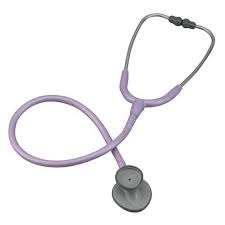The lightweight stethoscope is used to perform auscultation during clinical examinations. The wealth of physiological information largely offsets its apparent simplicity of design and use it provides concerning our state of cardiovascular, pulmonary or abdominal health.
What is a stethoscope?
The stethoscope is a medical instrument that allows you to practice auscultations, that is, listening to the internal sounds of the body. It is, therefore, an acoustic instrument that works by amplifying interior noises by resonance.
Composition
The traditional stethoscope consists of a pavilion covered with a membrane, on the back of which we can find a second bell, bell-shaped. The horn is connected to flexible rubber tubing that splits and is threaded on a metal frame in Y, the lyre. This is adjustable in spacing and carries at its ends the ear tips, removable and interchangeable.

Very sophisticated and efficient (and expensive) electronic stethoscopes exist, but their use is reserved for specialists for specific examinations.
Functioning
The sounds of the body are naturally muffled by the presence of organs, viscera, fatty tissue, bodily fluids, and they are "mixed" with each other in a commotion that makes them inaudible.
The stethoscope, applied to the skin at the level of the organ whose sounds you want to listen to (the heart, lungs, etc.), will be able to select the sounds emitted by this organ and amplify them. The sounds "hit" the pinna, and the triggered acoustic wave propagates along with the tubing and the lyre to the ear tips. It is the difference in size between the horn and the tips that explain the sound's amplification by a phenomenon of resonance.
What is a stethoscope used for?
The term stethoscope comes from the Greek ethos (chest) and scope (to observe). Therefore, it is used during clinical examinations to listen to the sounds of the heart or the lungs and listen to those of the blood vessels or the intestines.
Auscultation of blood vessels
The stethoscope can take the arterial pulse, measure blood pressure when used in conjunction with the blood pressure monitor, or detect and identify certain heart murmurs. Because of all it is necessary to buy Best stethoscope for paramedics.
Abdominal auscultation
It is very important to buy the Best EMT Stethoscope as the stethoscope allows you to listen to airborne noises from the intestines and thus detect an obstruction or paralysis of the digestive tract.
Other uses of the stethoscope
The littmann lightweight stethoscope is also commonly used in fields other than medical:
- To research explosive devices firing systems;
- To locate a plumbing leak;
- To identify a strange noise in mechanics;
- To find the secret code of an armored door or a safe.
How to choose the right stethoscope?
Depending on the intended use, there are different types of stethoscopes.
The different stethoscope models
- The monobloc chest piece stethoscope, ideal for taking blood pressure;
- The tiny head stethoscope, for infants and children, or very skinny people;
- Pinard's obstetrical stethoscope (made of a wooden or aluminum cone) to listen to the fetal heart;
- The cardiological stethoscope, with high acoustic sensitivity, to detect cardiac disorders;
The electronic stethoscope isolates and amplifies sound up to 18 times more than a traditional stethoscope.